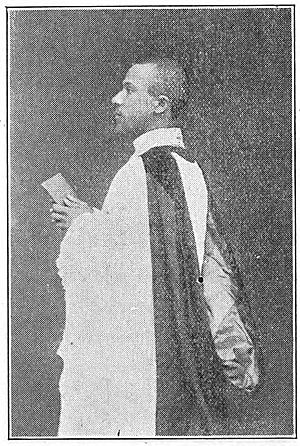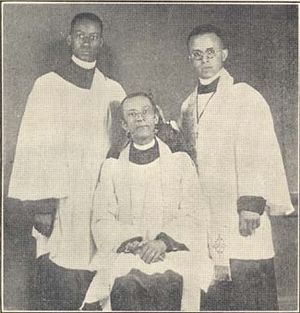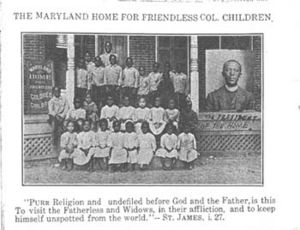George Freeman Bragg facts for kids
Quick facts for kids
George Freeman Bragg
|
|
|---|---|
 |
|
| Born | January 25, 1863 |
| Died | March 12, 1940 (aged 77) Baltimore, Maryland, US
|
| Occupation | Priest |
| Known for | Afro-American activist |
| Spouse(s) | Nellie Hill |
| Relatives | Lucinda Bragg Adams (sister) |
George Freeman Bragg (born January 25, 1863 – died March 12, 1940) was an important African-American priest, journalist, social activist, and historian. He was the twelfth African American to become a priest in the Episcopal Church in the United States. He worked hard to fight against unfair treatment based on race and to bring people of different races together, both inside and outside his church.
Contents
Early Life and Family
George Freeman Bragg was born into slavery in Warrenton, North Carolina, in 1863, during the American Civil War. After the war ended, his parents, George Freeman Bragg (a carpenter) and Mary (a seamstress), moved their family to Petersburg, Virginia. They lived with his grandmother, Caroline Wiley Cain Bragg, who was a very religious Episcopalian and had been a slave of an Episcopal priest.
Petersburg was known for having a successful community of free black people even before the war. The city's Episcopal churches soon started Sunday schools for black children. These schools helped prepare them for life as citizens.
Education and Religious Training
In 1867, Major Giles Buckner Cooke, a former Confederate army officer, started a Sunday school for freed slaves at St. Paul's Episcopal Church in Petersburg. The next year, George's grandmother, Caroline Bragg, helped start St. Stephen's Episcopal Church. This was Petersburg's first black Episcopalian church, and many of her family members joined.
In 1869, Petersburg began setting up public schools for black children. Cooke became the principal of the first elementary school. Later, he formed a private school and then added a divinity school to train future religious leaders. Young George Bragg was one of the first students at Saint Stephen's Normal and Industrial School. This school later became the Bishop Payne Divinity School. Another famous student from this school was James Solomon Russell, who later founded Saint Paul's Normal and Industrial School.
On September 20, 1887, Bragg married Nellie Hill, who came from another well-known black family in Petersburg. They had two sons and two daughters.
Journalism and Political Work
As a child, George Bragg delivered newspapers. This helped him meet important white leaders in the city, like John Hampden Chamberlayne, who was the editor of the Petersburg Index. Chamberlayne was a political friend of William Mahone, who started the Readjuster Party and asked black voters for their support.
Bragg started studying to become a priest, but he was asked to leave the school. He then became involved in politics, working for Mahone. Because of his efforts, he became a page in the House of Delegates in Richmond in 1881–82.
Starting a Newspaper
On July 1, 1882, Bragg started a weekly newspaper called the Petersburg Lancet. This paper focused on civil rights issues. However, after the Readjuster Party lost elections in 1883, Bragg became disappointed with politics. He felt that Mahone only cared about black votes, not their civil rights.
So, on September 12, 1885, Bragg announced that the Lancet would stop focusing on politics. Instead, it would focus on moral, educational, and business topics. The next February, he changed the paper's name to the Afro-American Churchman. Later, it became The Church Advocate. Around this time, Bragg was also able to go back to the Bishop Payne Divinity School, and he graduated in 1886.
A Life in Ministry
Bragg became a deacon on January 12, 1887. He was sent to Holy Innocents Episcopal Church in Norfolk. He successfully argued against a rule that made black deacons wait five years before becoming priests. So, on December 19, 1888, Bishop Francis McNeece Whittle made Bragg a priest. This made Bragg the twelfth black Episcopal priest. Over the next five years, Bragg helped his church grow and become self-supporting. He also started the Industrial School for Colored Girls.
Leading St. James Episcopal Church
In 1891, Bragg moved to Baltimore to become the leader of St. James Episcopal Church. This was the oldest black Episcopal church in the South, founded in 1824. He served there for 49 years until he died. When Bragg arrived, the church had only 63 members and was struggling. Under his leadership, it grew and became self-supporting again. The church tripled in size and built a new building by 1901.
By 1924, St. James was one of the largest black Episcopal churches in the country, with over 500 members. During the Great Depression, the church bought a larger building from a white congregation. On Easter Sunday 1932, Bragg led the first service in their new church building, which is still used today.
Fighting for Civil Rights
Bragg continued his work as a social activist, fighting against racism and Jim Crow laws. These laws enforced segregation and discrimination. In 1899, he helped create a black orphanage in Baltimore called the Maryland Home for Friendless Colored Children. Three years later, he helped Booker T. Washington start the Committee of Twelve. This group worked to prevent black people from losing their right to vote in Maryland. He also pushed for African-American teachers to teach African-American children in Baltimore's schools.
Bragg later joined W. E. B. DuBois as one of the founders of the Niagara Movement. This group was an early step towards the National Association for the Advancement of Colored People (NAACP). Bragg also kept publishing his monthly newspaper, The Church Advocate. He wrote several books and helped train more than 20 black ministers.
Bragg believed that the church should also focus on helping African American congregations in the United States, not just on mission work overseas. He worked to support the election of black bishops. He was considered for this role twice but was never chosen. However, Wilberforce University gave him an honorary degree in 1902.
Death and Legacy
George Freeman Bragg passed away on March 12, 1940, in Baltimore. The Baltimore Sun newspaper praised his calm manner, dignity, and his work for peace between different races. Four years after his death, his church bought and dedicated an altar in his memory.
His writings and important papers are kept at the New York Public Library and Howard University's Moorland-Springarm Research Center.
Major Works
Bragg wrote many books and articles, including:
- The Colored Harvest in the Old Virginia Diocese (1901)
- Afro-American Church Work and Workers (1904)
- The Story of Old St. Stephen's, Petersburg, Va. (1906)
- The First Negro Priest on Southern Soil (1909)
- A Bond-Slave of Christ: Entering the Ministry Under Great Difficulties (1912)
- Men of Maryland (1914), (1925)
- The Episcopal Church and the black man (1918)
- History of the Afro-American Group of the Episcopal Church (1922)
See also
- List of slaves



